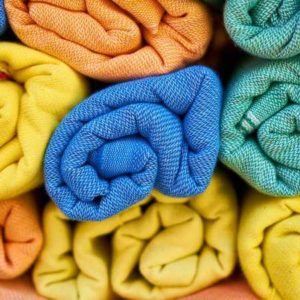Wool: A Versatile Fiber with a Rich History
Wool is one of the most versatile fibers in the world, and it has been used for centuries to create clothing, blankets, carpeting, felt, and even soil fertilizer. Wool is obtained from sheep and other animals such as goats, muskoxen, and rabbits. It is easy to spin and has scaling and crimp, which make it more bulky and allow it to retain air and heat, making it good for insulation.
The history of wool dates back to the domestication of sheep by humans somewhere between 9000BC and 7000BC. However, the sheep were more hairy than wooly and had to be bred by selection around 6000BC. The first woven wool garments date from 400BC to 300BC, and woolly-sheep came to Europe from the Near East around the same time. In medieval times, the wool trade became a serious business, with whole series of fairs mainly based on wool trading, and the economy of whole regions depending on it.
England and Castile were major exporters of raw wool, and wool trade was so important for England that it imposed special tax laws on wool export. The Medici and other great houses of Florence built their wealth on their textile industry based on wool. In the 16th century, Spain allowed the export of Merino lambs, a breed of sheep that gives highly valued type of wool, only with royal permission. The German wool market in time overtook British wool, which in turn was overtaken by Australia’s colonial economy that was based on sheep raising.
The Origin and Spread of Merino Sheep
Merino sheep have a fascinating history, originating in Spain and later spreading throughout the world. In 1789, King Charles IV of Spain gave six Merino sheep as a gift to the Dutch government. These sheep eventually found their way to South Africa, where they were sold to British army officer, politician, and entrepreneur John Macarthur. Macarthur then took them to Australia, where they thrived in the climate and eventually led to Australia producing 80% of the world’s Merino wool used in luxury fashion and suiting.
The Fall of Wool Production
However, wool production fell in the middle of the 20th century due to the appearance of synthetic fibers. Wool, which was once the dominant material for clothing, fell out of favor as consumers sought out cheaper and more convenient options. In order to stay competitive, the wool industry had to innovate.
Wool: A Versatile Fiber with Practical Applications Beyond Fashion
Wool is a versatile fiber that has been used for centuries to create clothing, blankets, carpeting, felt, and even soil fertilizer. In modern times, wool has found many practical applications in our daily lives, beyond just fashion.
Wool for Clothing and Accessories
Wool’s natural properties make it a great choice for clothing and accessories, particularly during colder months. Its insulating properties make it a great choice for staying warm, and it is also naturally moisture-wicking, helping to regulate body temperature. Wool is used to make a wide range of garments, including sweaters, coats, socks, hats, and scarves, and it can also be blended with other fibers for added durability and softness.
Wool for Home Textiles
Wool’s versatility extends beyond clothing, being used for blankets, horse rugs, carpeting, felt, and upholstery. Wool’s natural durability and resistance to staining make it a popular choice for carpeting and upholstery, and its insulating properties make it a great choice for blankets and horse rugs.
Wool for Insulation
Wool insulation is a sustainable and natural alternative to synthetic insulation materials. Wool insulation is non-toxic, flame-resistant, and can be recycled at the end of its useful life. It is also naturally moisture-wicking and breathable, helping to regulate temperature and prevent mold growth.
Wool for Protective Garments
Wool can also be used to produce protective garments worn by firefighters and soldiers. Wool’s natural flame resistance and insulating properties make it an ideal material for protective clothing. Wool also has the added benefit of being naturally moisture-wicking, helping to keep the wearer dry and comfortable.
Wool as Soil Fertilizer
Wool can also be used as a soil fertilizer, helping to improve soil quality and promote plant growth. Wool contains essential nutrients like nitrogen, phosphorus, and potassium, and its slow-release properties make it an effective fertilizer.
Sustainability and Production
Today, wool accounts for 0.9% of the global fiber market. In 2021, around 1.2 billion sheep produced approximately 1,945 million kilograms of raw wool for use in textiles for home and clothing. Despite competition from synthetic fibers, wool remains a valuable and sustainable resource with a rich history and countless practical applications. The wool industry has also developed superwash wool, a type of wool that is specially treated so it can be machine-washed and tumble-dried, making wool more convenient for consumers.
In conclusion, wool is a versatile and sustainable material with many practical applications in our daily lives. Whether you’re looking for clothing, home textiles, insulation, protective garments, or soil fertilizer, wool is a great choice. With its natural properties and long history, wool is a valuable resource that is here to stay.
If you’re looking for a sustainable and versatile material, wool is a great choice. It is biodegradable and renewable, and when properly cared for, can last for years. Additionally, wool’s insulating properties make it a great choice for staying warm during colder months.
In conclusion, wool is a remarkable fiber that has a rich history and is still used today in many applications. Its natural properties make it a great choice for both fashion and function. If you’re interested in sustainable and versatile materials, wool is a great option to consider.








Wow, I never thought about this subject in the way you presented it. Your unique take adds a new dimension to the conversation, and I’m excited to delve deeper into this topic now regarding the history and versatility of wool. Thanks for sharing.